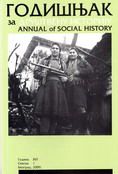Округ Чачак 1915-1918: последице окупације на свакодневни живот становништва
The County of Čačak 1915–1918: Consequences of the Occupation on everyday life
Author(s): Bogdan TrifunovićSubject(s): History
Published by: Udruženje za društvenu istoriju
Keywords: Cacak; everyday life; occupation; mortality; nutrition; diseases; Austria-Hungary
Summary/Abstract: Mortality rate in the county during the first four months of 1916 was very high (49% of all cases that year), from which almost a half (44%) were children under 15 years of age. Somewhat better conditions in 1917, better harvest and relatively consolidated health conditions in the county enabled positive population growth in that year... Everyday life in this part of Serbia during the occupation times was very difficult because of decrease of agriculture of up to 40% when compared with pre-war times. During the occupation, food production was insufficient even for rationing and forced ransom, while humanitarian donations rarely reached this part of Serbia. Until August of 1916 medication was mainly done at home, out of rare health facili ties, and by use of strong brandy as traditional cure for many illnesses. Many poor habits, along with poor hygiene, small number of physicians, and lack of medical care for civilians by the occupant, fostered many illnesses. Among them, most dangerous were tuberculosis, typhoid fever, malaria and venereal diseases.
Journal: Godišnjak za društvenu istoriju
- Issue Year: 2009
- Issue No: 1
- Page Range: 45-68
- Page Count: 24
- Language: Serbian

